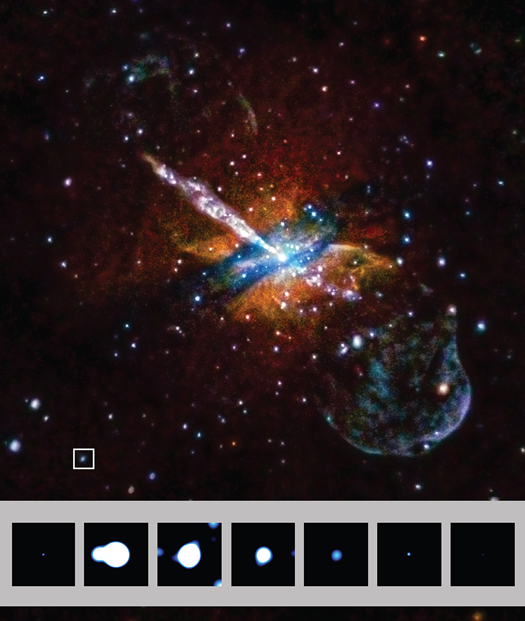For Release: October 19, 2016
CXC
Astronomers have found a pair of extraordinary cosmic objects that dramatically burst in X-rays. This discovery, obtained with NASA's Chandra X-ray Observatory and ESA's XMM-Newton observatory, may represent a new class of explosive events found in space.
The mysterious X-ray sources flare up and become about a hundred times brighter in less than a minute, before returning to original X-ray levels after about an hour. At their peak, these objects qualify as ultraluminous X-ray sources (ULXs) that give off hundreds to thousands of times more X-rays than typical binary systems where a star is orbiting a black hole or neutron star.
"We've never seen anything like this," said Jimmy Irwin of the University of Alabama, who led the study that appears in the latest issue of the journal Nature. "Astronomers have seen many different objects that flare up, but these may be examples of an entirely new phenomenon."
While magnetars - young neutron stars with powerful magnetic fields - have been known to produce bright and rapid flares in X-rays, these newly discovered objects are different in key ways.
First, magnetars only take a few seconds to tens of seconds to decline in X-rays after a flare. Secondly, these new flaring objects are found in populations of old stars in elliptical galaxies, which are spherical or egg-shaped galaxies that are composed mostly of older stars.
This makes it unlikely that these new flaring objects are young, astronomically speaking, like magnetars are thought to be. Also, these objects are brighter in X-rays during their "calm" periods.
"These flares are extraordinary," said Peter Maksym, a co-author from the Harvard-Smithsonian Center for Astrophysics. "For a brief period, one of the sources became one of the brightest ULX to ever be seen in an elliptical galaxy."
When they are not flaring, these sources appear to be normal binary systems where a black hole or neutron star is pulling material from a companion star similar to the Sun. This indicates that the flares do not significantly disrupt the binary system.
While the nature of these flares is unknown, the team has begun to search for answers. One idea is that the flares represent episodes when matter being pulled away from a companion star falls rapidly onto a black hole or neutron star. This could happen when the companion makes its closest approach to the compact object in an eccentric orbit. Another explanation could involve matter falling onto an intermediate-mass black hole, with a mass of about 800 times that of the Sun for one source and 80 times that of the Sun for the other.
"Now that we've discovered these flaring objects, observational astronomers and theorists alike are going to be working hard to figure out what's happening," said co-author Gregory Sivakoff of the University of Alberta.
One of the sources, located near and presumably associated with the galaxy NGC 4636 at a distance of 47 million light years, was observed with Chandra to flare once. Five flares were detected from the other source, which is located near the galaxy NGC 5128 at a distance of 12 million light years. Four of these flares were seen with Chandra and one with XMM-Newton.
The team looked at the X-ray variation of several thousand X-ray sources in Chandra observations of 70 nearby galaxies. Although several examples of flaring X-ray sources were found, none exhibited the behavior of the giant rapid flares reported here.
NASA's Marshall Space Flight Center in Huntsville, Alabama, manages the Chandra program for NASA's Science Mission Directorate in Washington. The Smithsonian Astrophysical Observatory in Cambridge, Massachusetts, controls Chandra’s science and flight operations.
An interactive image, a podcast, and a video about the findings are available at:http://chandra.si.edu
For more Chandra images, multimedia and related materials, visit:
http://www.nasa.gov/chandra
Media contacts:
Megan Watzke
Chandra X-ray Center, Cambridge, Mass.
617-496-7998
mwatzke@cfa.harvard.edu



Visitor Comments (2)
It is possible, that those ultra luminous flares could be produced by falling a huge compact body, like a big planet and or a brown dwarf orbitting the star, onto the black hole.
Posted by Richard Å Ãma on Friday, 11.4.16 @ 07:37am
In an accreating binary system, atmospheric waves sloshing about the source star could modulate the rate of mass transfer into pulses. The mass loss gravitational dynamics from the source star could feed the source star's atmospheric oscillation. The atmospheric oscillation tides could be periodic or chaotic. Periodic in this case.
Posted by eric lindahl on Monday, 10.31.16 @ 15:55pm
[Contact us: cxcpub@cfa.harvard.edu]
60 Garden Street, Cambridge, MA 02138 USA
Phone: 617.496.7941 Fax: 617.495.7356
This site was developed with funding from NASA under Contract NAS8-03060.